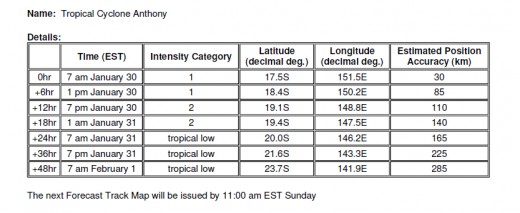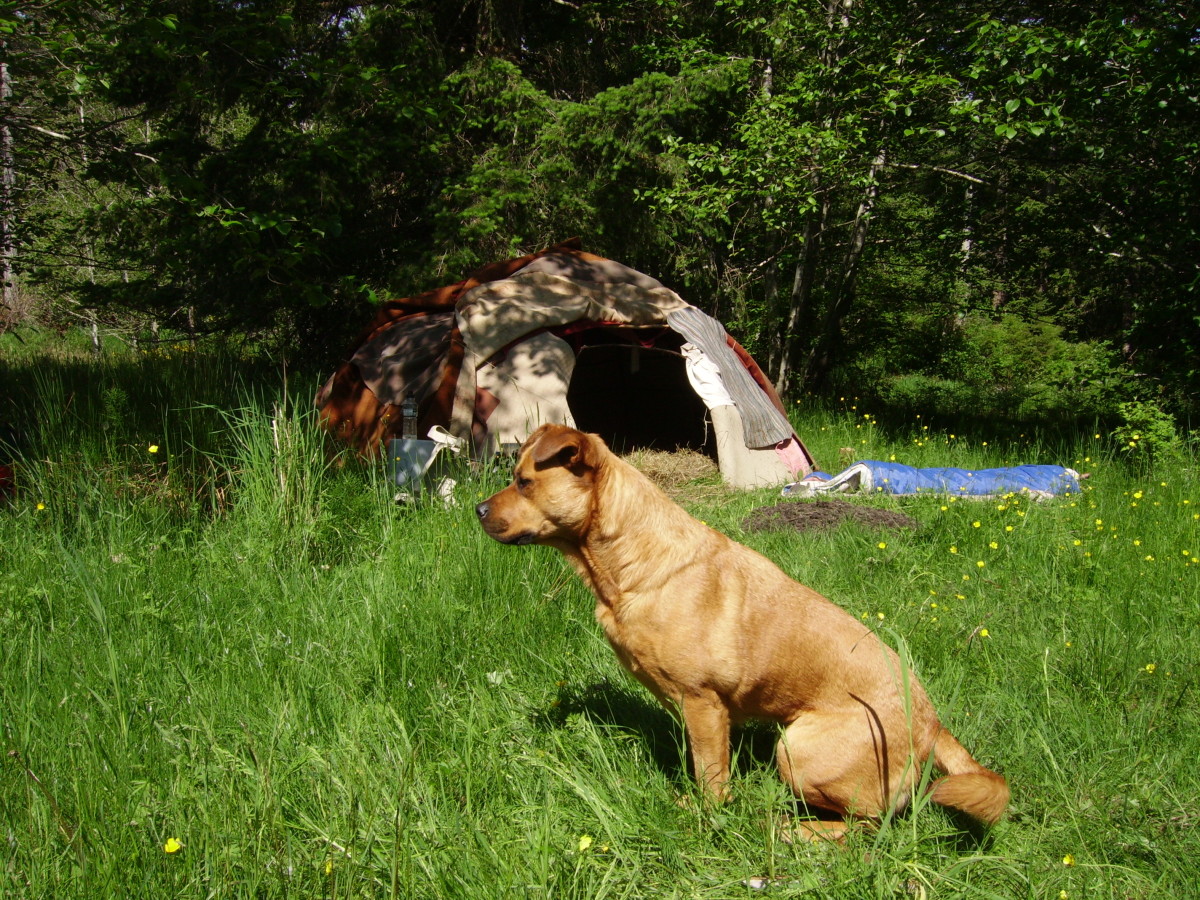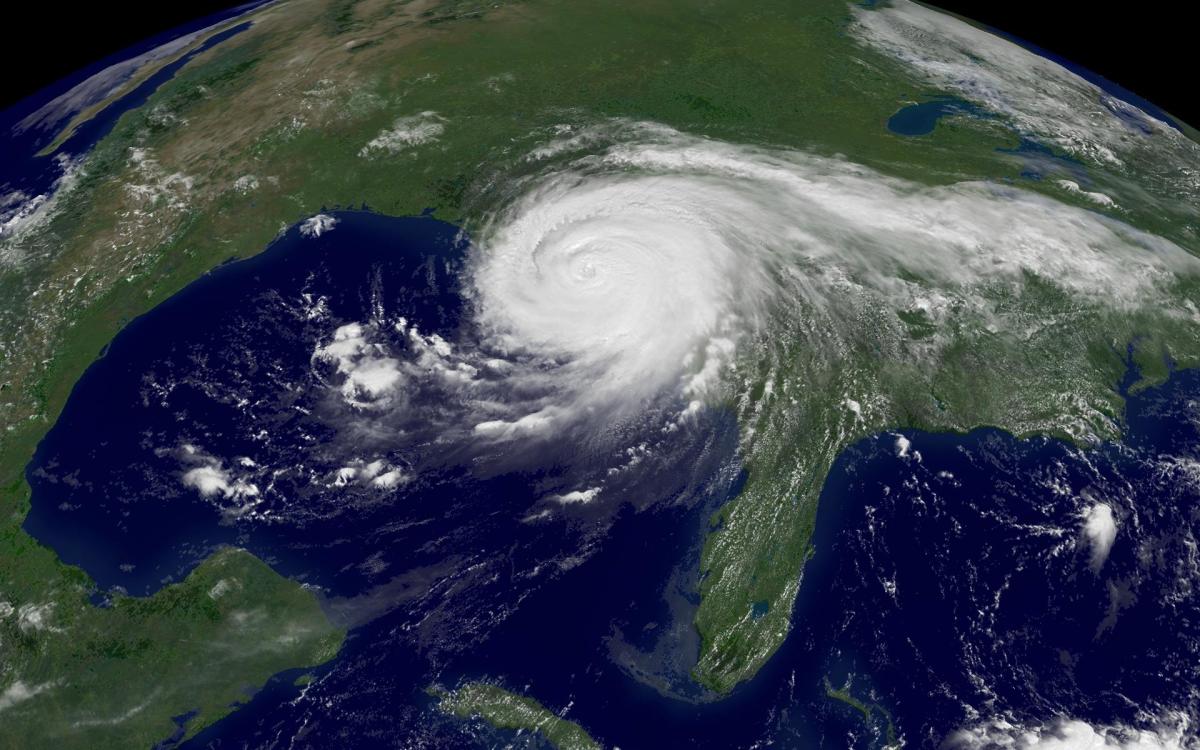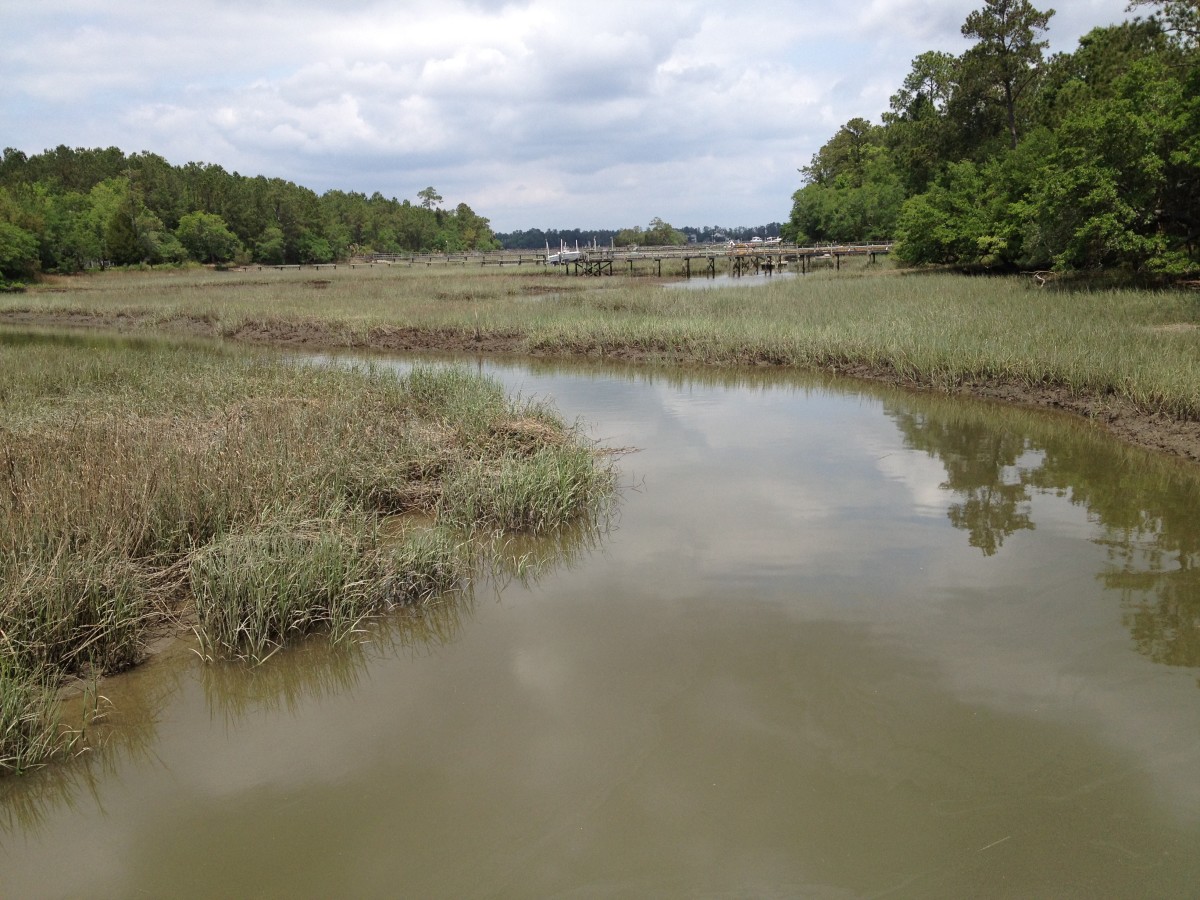Tropical Cyclone Anthony a Personal Account
There is something about the approach of a tropical cyclone. It is a feeling in the air and in your bones that is as indescribable as the cyclone itself. As I collect my last minute essential items at the local store I get a sense of uneasiness hidden behind the smiling faces of ordinary people doing the same thing as me. Understanding all of the sensory perceptions that are brought into play because of an impending cyclone, I’m not sure why, when I returned home that I picked up the binoculars to scan the horizon except that I wanted to see, for myself, if anything had changed. It was at that moment I wondered how much technology influenced the way people prepared for a cyclone today compared with days gone by.
Preparing for a Cyclone

If I hadn’t been listening to the radio at the time when the media reports first advised Tropical Cyclone Anthony was on his way, would I have been aware at all? Were these feelings simply a reaction to watching the updates from the weather channel or am I instinctively aware? We had been well forewarned that a cyclone was on its way through television, radio and updates from the Bureau of Meteorology’s website (BOM) for the previous three days. A tropical low had formed into a cyclone category 1 as it left the reporting waters of Fiji. The tracking map on the BOM site showed clearly where they expected it to cross land on the north east coast. They were also able to predict what category level it would be when it arrived and within 100 kilometres of where it would land.
Apart from the reports from the media, there was no mistaking the atmosphere had taken on an eerie stillness. Where were the birds that normally flit from tree to tree or stop by the bird baths dotted around my balcony? A flock of ten or twelve red tailed black cockatoos screeched a call through the valley to the east of our property and continued the call all the way to the bay in the north. It was as if the call had taken all the birds with it. The sulphur crested cockatoos, the yellow throated honeyeaters, the sunbirds and even the spangled drongos have disappeared and the air is silent. I am struck with the realisation that there are no birds to be heard or seen.
It was at that moment, I became acutely aware that the normal traffic noises filtering up the hillside from the main road is now at a minimum. I guess most of the local residents are now well prepared, stocked up on the essentials and have made their way home to safety. My thoughts are interrupted with another update from the local radio station reminding residents to be prepared.
Cyclone Anthony Statistics
Cyclone Anthony crossed land at ten minutes before midnight on 30 January 2011.
Wind Gusts Followed by Rain
Preparing for a cyclone has become commonplace even though we have only lived in the cyclone risk area for a little over a year. Cyclone Ului, Category 3 actually passed directly over us eleven months ago. We experienced then the eye of the cyclone followed by the destructive winds and know it is important to take the information fed to us by the media, seriously. As the wind speeds start to increase, I wonder where my husband is. Surely he has had more than enough time to collect those last minute items and be on his way home?
The gusts of wind begin sporadically; I can feel them before I see them. Living on a hillside gives me a perspective to the weather I have not experienced before. When there is rain about I can watch the sky change in an instant then hear the rush of a shower as it makes its way up the hillside. Today the sky has a glow about it in keeping with those tropical afternoon storms but there is something about the light filtering through the clouded skies that lets me know, this is different.
The rain starts again but with it comes a breeze that sends a splatter of raindrops my way. The raindrops come sideways giving me warning it may be time to move inside. Within minutes, my computer screen is covered with a light spitting of water. In a moment I am concerned about my preparations. I’m not sure if I have prepared well enough, but as I go through my mental checklist I think I have probably over prepared. I don’t have a problem with that for I know it is always better to be safe than sorry.
The windows are taped in a criss-cross fashion. This will not stop the glass from breaking but if it does the concept is that the glass may not shatter. I have the emergency kit at the ready. The emergency kit comprises of a battery operated radio and lantern in case we lose power. I have our insurance policy for the house as well as passports and other legal documents, all wrapped in plastic inside a waterproof container. There is another container full of non-perishable foods, tinned and packaged, along with supplies for the dogs.
Tracking Map for Cyclone Anthony 1
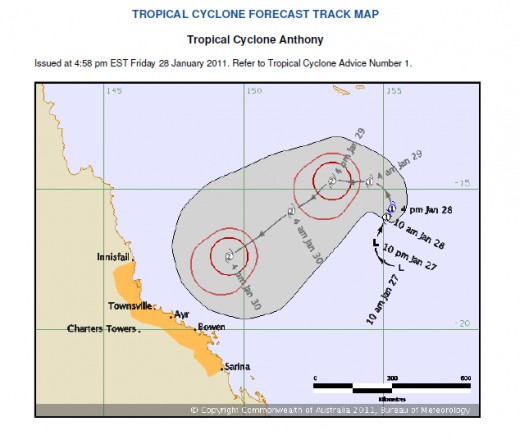
Global Perspectives

The Power Goes Out
The wind has been howling for over an hour before my husband arrives home. Much to my relief he is safe and oozes confidence. He fills the water containers and removes the last of the objects from the balcony, those I haven’t been able to reach. We work together to close the doors and windows, otherwise known as battening down the hatches and wait. The wind has become a constant low whistle. We watch with baited breath as the gusts pick up to 100 kilometres an hour and the branches of the trees lean sideways. The sun goes down and it is somehow comforting to hear the wind without being able to see how destructive it may be.
Dinner is a reheat of the night before as simple and easy as we can get given the circumstance. I look at my husband across the dining table and am reassured by his confidence in our preparations. It is not long after that we lose power, around nine in the evening so we have to resort to the battery operated radio for information on where the cyclone is and where it is headed.
Tracking Map for Cyclone Anthony 10
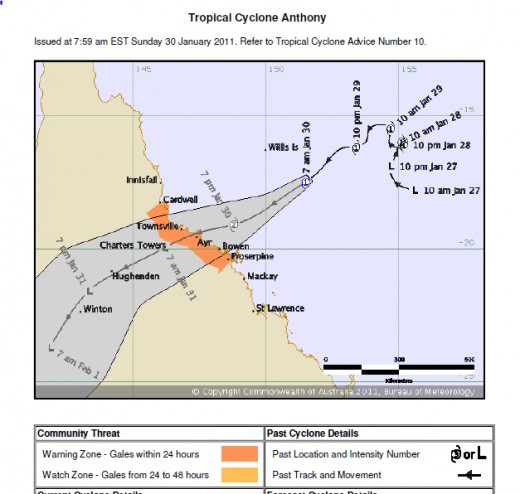
Come on Over
The Queensland Government wants everyone to know that the state is open for business. Recovery after the floods and recent cyclones has happened quickly and there are many tourist places opening their doors to the wider public. There are blue skies, blue seas and all the usual tropical delights ready and waiting. Help put Queensland back on its feet. Come and visit and enjoy all that paradise has to offer.
Doris is from a town a little further to the north of us and has rung in to the local radio station to share her experience. She has been listening to the radio and heeded all the warnings. Earlier in the day, the cyclone was headed directly to her town so she has, quite rightly, spent the day making all the right preparations. But instead of being relieved at the announcement that the eye of the cyclone will head south of her location her voice resonates with disappointment.
For us, this is a bit of a worry. South, means the cyclone is moving closer to us. My husband reassures me we will be alright. Cyclone Ului crossed as a category 3 whereas this one, Cyclone Anthony was a category 2, a much weaker system. The following is an explanation of the different wind speeds that determines a category grade.
Category
| Wind Speed Miles/Kms
| Potential Wind Gusts Miles/Kms
| Beaufort Scale
|
|---|---|---|---|
1
| 56/90
| 78/125
| 8 or 9
|
2
| 78/125
| 102/164
| 10 or 11
|
3
| 103/165
| 139/224
| 12
|
4
| 140/225
| 173/279
| 12
|
5
| 174/280+
| 174/280+
| 12
|
Cyclone Yasi is on its Way
It is about an hour after the power goes out that a caller rings the radio station to report the eye of the cyclone has passed over their house. The caller lives 80 kilometres (50 miles) to the north so we know the danger has passed. Unlike Doris, we are relieved. There is no disappointment in having prepared our home for the worst, we know nothing but gratitude and count our blessings.
The weather channel advises of a much larger system headed our way. Cyclone Yasi is forecast to cross the north Queensland coast in three days as a category 4 system. Once again we are in the warning area so it looks as if the tape on the windows may have to stay for a few more days yet.
Copyright © 2011 Karen Wilton
